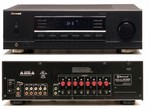I'm an audio freak and always keeping a close eye on hifi equipment and prices. This discontinued dual stereo receiver from Sherwood is an amazing piece of equipment especially for only $149 in as-new condition. Most other stockists like JB Hi-fi, Ebay or actual specialist Hi-Fi stores stock this item for $380-450.
What sets this piece of equipment apart is the ability two run dual zone stereo with an A/B/C/D configuration. This means there are two 100Wx2 RMS amplifiers (THD 0.2%, 8ohm) built in to the unit that can run up to 4 sets of stereo speakers at 4x35W. So you can have a pair of speakers in your lounge, kitchen, deck and bedroom all from the one receiver playing up to 2 different audio sources. A/B are considered zone 1 (100Wx2 amp #1) and C/D are zone 2 (100Wx2 amp #2).
This unit isn't ideal for movies or blu-ray. It's for stereo music listening, it does that alone and does it well. It also features a phono-input for anyone out there looking to connect up an old (or new) turntable. Obviously you could hook up any stereo source, including mp3, your pc, CD player, tape deck, or even the line out from your main TV/receiver. It's a serious bargain. Reliability is actually fantastic. Go read reviews at Amazon here: http://www.amazon.com/Sherwood-Dual-Zone-Receiver-Discontinu…
I bought one for pick up from my local store, and if you're looking for a cheap and easy entry in to home Hi-Fi or just a separate stereo for your bedroom or what have you, this is the way to go. For real. Happy Friday!


THD 0.2%……. more like 0.08%